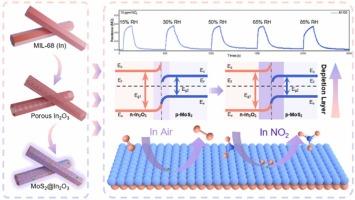金属-有机框架衍生In2O3@MoS2纳米复合材料:在近室温下实现高灵敏度的NO2传感,具有强大的湿度耐受性
IF 3.7
1区 化学
Q1 CHEMISTRY, ANALYTICAL
引用次数: 0
摘要
在复杂的实际环境中,具有特殊抗干扰能力的气体传感器是非常需要的。然而,开发基于金属氧化物的二氧化氮气体传感器,在相对较低的温度下保持优异的耐湿性仍然是一个重大挑战。在这项工作中,成功制备了金属有机框架衍生的In2O3@MoS2异质结,该异质结具有低工作温度,高选择性和优异的耐湿性等特点。值得注意的是,在接近室温的情况下,在15%-85%的相对湿度(RH)范围内,传感器的响应波动仅为1.03%至10ppm NO2,可以忽略不计。即使在65%的相对湿度条件下,它仍然达到50 ppb的低检测限制。进一步分析表明,边缘端不饱和硫(S)原子是增强传感性能的关键因素。多孔结构和增强的电荷转移也有利于增强。这些发现突出了In2O3@MoS2-based气体传感器作为高湿度环境中可靠的NO2检测的有希望的候选者的潜力。本文章由计算机程序翻译,如有差异,请以英文原文为准。

Metal-organic framework-derived In2O3@MoS2 nanocomposites: Enabling highly sensitive NO2 sensing with robust humidity tolerance at near-room temperature
In complex practical environments, gas sensors with exceptional anti-interference capabilities are highly desirable. Nevertheless, developing metal oxide-based NO2 gas sensors that maintain excellent humidity resistance at relatively low temperatures remains a significant challenge. In this work, Metal-organic framework-derived In2O3@MoS2 heterojunctions were successfully fabricated, which demonstrate remarkable NO2 sensing performance characterized by low operating temperature, high selectivity, and outstanding humidity tolerance. Significantly, at near room temperature, the sensor demonstrates negligible response fluctuation of only 1.03 % to 10 ppm NO2 across a wide relative humidity (RH) range of 15 %-85 %. Even at 65 % RH conditions, it still achieves a low detection limitation of 50 ppb. Further analysis reveals that edge-terminated unsaturated sulfur (S) atoms are the key factor for the enhanced sensing performance. Both porous strueture and enhanced charge transfer are also conducive to the enhancement. These findings highlight the potential of In2O3@MoS2-based gas sensor as promising candidates for reliable NO2 detection in high-humidity environments.
求助全文
通过发布文献求助,成功后即可免费获取论文全文。
去求助
来源期刊

Sensors and Actuators B: Chemical
工程技术-电化学
CiteScore
14.60
自引率
11.90%
发文量
1776
审稿时长
3.2 months
期刊介绍:
Sensors & Actuators, B: Chemical is an international journal focused on the research and development of chemical transducers. It covers chemical sensors and biosensors, chemical actuators, and analytical microsystems. The journal is interdisciplinary, aiming to publish original works showcasing substantial advancements beyond the current state of the art in these fields, with practical applicability to solving meaningful analytical problems. Review articles are accepted by invitation from an Editor of the journal.
 求助内容:
求助内容: 应助结果提醒方式:
应助结果提醒方式:


